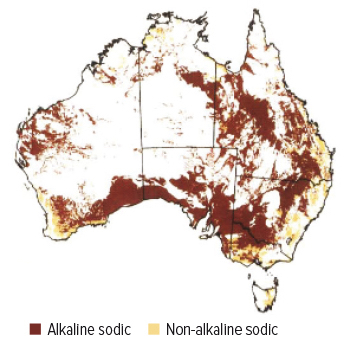The challenge
Paddocks with sodic subsoils are widespread in the cropping zones and impose limitation to grain yield by restricting root growth. These constraints currently affect 7 million hectares of duplex soils nationally. This is equivalent to 31 per cent of the Australian grain cropping hectares.
Besides restricting root growth, sodic soils are more susceptible to clay dispersion and surface sealing, which generates runoff flow following rainfall events. The extent of a soil’s dispersive behaviour varies with its salinity.
Non-saline sodic soils are usually dispersive, have high bulk density, weak structural stability, and low hydraulic conductivities and infiltration rates. These poor physical properties further impact crop productivity by reducing aeration and water supply.
Sodic soils are usually found in low-slope sections of the landscape, often on valley floors. In the Western Australian wheatbelt, more than a third of the total area has sodic clay layers. In Victoria, alkaline sodic soils occupy about 37 per cent of the State’s cropping land and neutral sodic soils occupy about 10 per cent.
 Figure 1. Extent of sodic soils in Australia.
Figure 1. Extent of sodic soils in Australia.
The response
GRDC invested in a combination of projects nationally to understand current constraints of sodic soils and potential management and genetic solutions to yield limitations.
Work on the four sodic soil projects was undertaken between 2015 and 2023. It was performed by the Colere Group, Department of Primary Industries and Regional Development, Mingenew-Irwin Group Inc and The University of Adelaide.
These investments targeted key leverage points when it comes to mitigating the impact sodic soils have on grain production, starting with the technology needed to map and diagnose the soil profile at three-dimensional scales.
The investment strategy then proceeded to options to increase crop available water, including water harvesting techniques, gypsum application, stubble management, soil amendments with polymers or organic material and on-the-go-management options for growers.
And it culminates with the development of germplasm with improved tolerance to sodic soils.
The four investments on sodic soils were:
- Identify knowledge gaps in 3D soil diagnostics to advance soil amelioration using 3D mapping tools (COG2009-001CAX);
- Build expertise around water harvesting using biodegradable mulches, in-furrow gypsum application, mineral mulches, deep tillage in sodic clays and deep placed organics in dry environments (DAW1902-001RTX);
- Improve understanding of how different varieties perform on sodic soils and developing new germplasm with improved genetic tolerance to sodic soils (UOA1507-002RMX) and
- Generate project management lessons around matching project scope to the available resources and the importance of the research design before implementation (MIG1801-001SAX).
The impact
The present value of investment (PVI) in these four projects is $21 million. The returned benefits have a present value of $219 million and a net present value of $198 million for a benefit cost ratio of 10.4.
The package of investments is expected to have a positive net benefit on growers and opportunities for further benefits with additional research and development. These benefits are accruing around findings made across the four investments:
Soil mapping and diagnosis
- A detailed review of available technologies found that no one technology has all the required features or is able to provide all the diagnostics required. A combination of tools will be needed.
- The 3D diagnostic mapping technologies need to be further developed and commercialised but show technical promise.
- The 2D mapping provide immediate opportunities for practice change by visualising and specifying multiple soil constraints (rather than a single soil constraint) concurrently.
Water availability
Water harvesting technologies are assumed to cost growers approximately $180/ha. The costs of gypsum were $54/ha including gypsum, transport and spreading. The addition of mulches to soils is variable and depends on accesses to materials used in the amelioration process. For this analysis, the cost was assumed to be $1600/ha with corresponding yield benefits lasting for up to 10 years.
- Low rates of Gypsum application (less than 200kg/ha) in 2021 had no significant effect on crop yields but the combination of water harvesting and in-furrow amendments resulted in significant barley yield increases.
- Water harvesting alone using inter-row mounds and hydrophobic hats increased average yield for barley with 0.61 t/ha over the control in ten of the thirteen experiments.
- Application of a gravel mulch of 5 cm resulted in wheat grain yield increases of 1.9 t/ha (116 per cent) compared to the control.
Improved rooting depth
- Using gypsum and ripping on soil types where sodicity is deeper than 30cm is not profitable. No yield responses were observed in the two years of research and no response was observed to the application of gypsum.
Breeding
- Germplasm was developed that yielded more than its parents on sodic soils.
- Progress was made in developing a marker for high pH tolerance.
- A soil-based screening method that may assist rapid screening of germplasm was designed.
- A main conclusion was to develop varieties with greater tolerance to sodicity should take account of regional differences.
Besides the development of new knowledge that is immediately applicable to the benefit of growers, recommendations from these projects is informing further investment, with tangible economic benefit likely to continue over the next five to 10 years.
The ex-post analysis of GRDC investments in sodic soils was conducted by the University of Western Australia.
More information: Delivering impact case studies.

























































